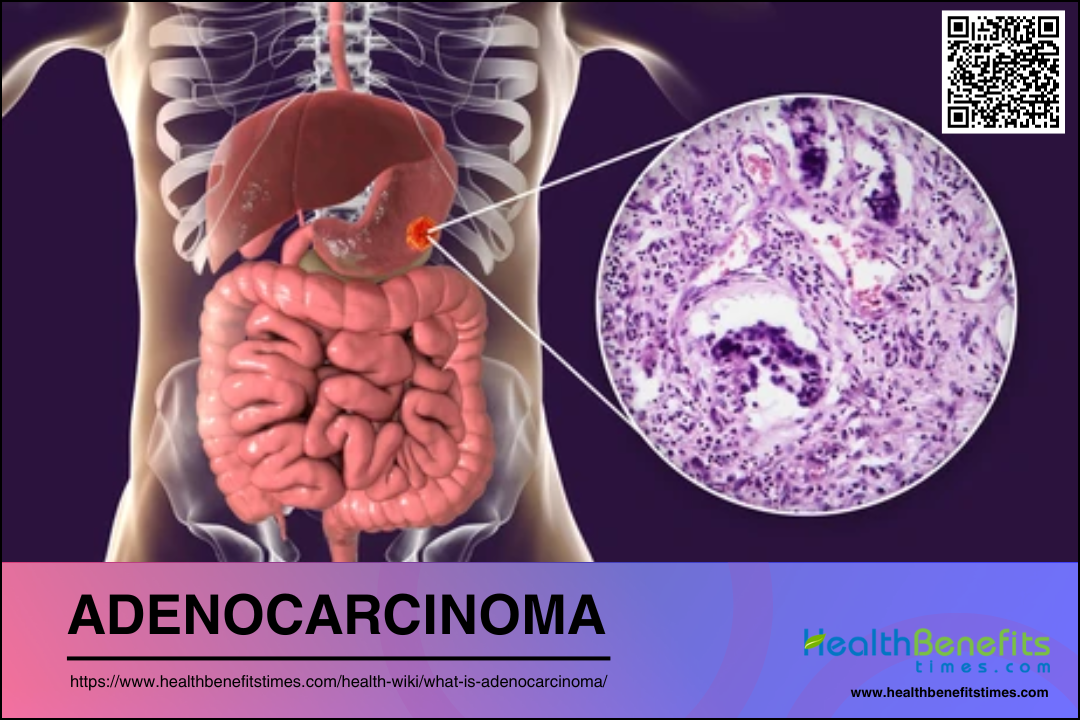 Adenocarcinoma is a type of cancer that forms in mucus-secreting glands throughout the body. It is the most common form of lung cancer, often diagnosed in both smokers and non-smokers, and has a variety of subtypes with different prognoses and treatment implications. It can impact multiple organs including the lungs, breasts, prostate, and colon. Early detection of this cancer is crucial, as its symptoms are typically mild and can go unnoticed. Awareness and understanding play a significant role in the holistic health community, empowering individuals to take proactive measures in maintaining their health and accessing timely, effective treatment. Integrating medical interventions with holistic approaches is essential not only for managing the cancer but also for enhancing overall well-being and enhancing quality of life for individuals navigating this challenging journey.
Adenocarcinoma is a type of cancer that forms in mucus-secreting glands throughout the body. It is the most common form of lung cancer, often diagnosed in both smokers and non-smokers, and has a variety of subtypes with different prognoses and treatment implications. It can impact multiple organs including the lungs, breasts, prostate, and colon. Early detection of this cancer is crucial, as its symptoms are typically mild and can go unnoticed. Awareness and understanding play a significant role in the holistic health community, empowering individuals to take proactive measures in maintaining their health and accessing timely, effective treatment. Integrating medical interventions with holistic approaches is essential not only for managing the cancer but also for enhancing overall well-being and enhancing quality of life for individuals navigating this challenging journey.
Body Parts which is prone of Adenocarcinoma
Although it may be a challenging diagnosis, knowing which body parts are most at risk can give individuals the information needed for early detection and prevention. The following is a list of body parts that are especially susceptible to developing adenocarcinoma, highlighting the significance of staying vigilant and undergoing regular health screenings.
1. Bowel
Adenocarcinoma, a type of cancer that originates in the mucus-secreting glands, can affect various body parts, but it is relatively rare in the bowel, particularly the small bowel. Despite the small bowel making up a significant portion of the digestive tract, it is less frequently affected by cancer compared to other regions such as the colon and stomach. However, certain conditions can increase the risk of developing adenocarcinoma in the bowel. For instance, longstanding Crohn’s disease has been associated with a higher incidence of adenocarcinoma in the small bowel, particularly in bypassed segments of the bowel. The bowel, which consists of the colon and rectum, is particularly vulnerable to this cancer that originates in the glandular cells lining the intestine, which are important for mucus production and nutrient absorption. Factors such as lifestyle choices, age, diet, and genetics all play a role in determining the risk of developing bowel adenocarcinoma.
2. Breast
Breast adenocarcinoma, a common type of cancer originating in the glandular tissue, poses a significant health risk due to its effects on both physical and emotional health. Early detection, often presenting as a lump, is essential for successful treatment through self-exams and mammograms. A comprehensive health approach highlights the significance of integrating medical interventions with lifestyle modifications, including a nutritious diet, consistent physical activity, and stress reduction, to enhance overall well-being and reduce cancer susceptibility. Routine screenings and a proactive stance towards health can improve treatment results and bolster resilience in individuals confronting this disease.
3. Cervix
The cervix is an important component of the female reproductive system that can be affected by adenocarcinoma, a cancer that originates from the glandular cells in the cervical canal. This condition is often linked to high-risk strains of the Human Papillomavirus (HPV). To prevent such cancers, it is crucial to undergo regular Pap smear screenings, which can detect early precancerous changes. Adopting a holistic approach to health, including maintaining a balanced diet, regular exercise, and stress management, can strengthen the body’s defenses and promote cervical health, reducing the risk of developing adenocarcinoma.
4. Kidney
The kidneys are vital organs responsible for filtering waste and maintaining the balance of salts and minerals in the body. Renal cell carcinoma (RCC), also known as renal adenocarcinoma, is the most common form of kidney cancer in adults, originating from the proximal convoluted tubules involved in blood filtration. Major risk factors for RCC include smoking, obesity, hypertension, and genetic predisposition. Adenocarcinoma of the kidney, particularly in the renal pelvis, is a rare but serious cancer. It often arises in the context of long-standing infection, calculous disease, or hydronephrosis. Early symptoms such as blood in the urine, back pain, and weight loss are often overlooked, underscoring the importance of regular health screenings for early detection and management of kidney health. Adopting a holistic approach to health, including a balanced diet, regular exercise, and avoidance of harmful substances, can help support kidney function and reduce the risk of developing RCC.
5. Lung
Adenocarcinoma, a common type of non-small cell lung cancer, presents a significant risk to lung health by affecting the glandular cells in the airways and often originating in the outer regions of the lungs. While factors such as smoking, exposure to environmental toxins, and genetic predisposition can increase susceptibility, this cancer also frequently impacts non-smokers, particularly women. To protect respiratory health, it is important to adopt a comprehensive health approach that includes regular exercise, a diet rich in antioxidants, and stress-reducing mindfulness practices, as well as ensuring clean air in both living and work environments. Early recognition of symptoms and screening for individuals at high risk are crucial for timely intervention, as early detection can greatly enhance treatment outcomes. The holistic health community plays a vital role in raising awareness and promoting proactive lifestyle choices to support lung health and reduce the prevalence of this serious disease.
6. Oesophagus
The oesophagus, a tube that connects the throat to the stomach, is crucial for digestion but can be susceptible to a cancer known as adenocarcinoma, especially in individuals with gastroesophageal reflux disease (GERD). GERD causes stomach acid to flow back into the esophagus, leading to Barrett’s esophagus, a condition that increases the risk of cancer. Studies have demonstrated a strong association between increased body mass index (BMI) and the risk of oesophageal adenocarcinoma, with a higher prevalence in males and a dose-dependent relationship with BMI. Adopting a holistic approach to health, which includes a balanced diet, stress management, and avoiding harmful behaviors like smoking and heavy drinking, is essential for preventing esophageal adenocarcinoma.
7. Pancreas
The pancreas is a critical organ for digestion and blood sugar regulation, and its location deep within the abdomen often leads to late presentation and diagnosis of cancer. However, it is susceptible to pancreatic adenocarcinoma, the most common form of pancreatic cancer. Adenocarcinoma of the pancreatic body and tail is less likely to be resectable compared to lesions in the head of the pancreas, but postresection survival rates are similar. This type of cancer is often not diagnosed until it has progressed significantly, as early symptoms such as abdominal pain, weight loss, and jaundice can be vague. Recognizing risk factors such as obesity, chronic pancreatitis, and a family history of pancreatic cancer is also essential. By understanding the pancreas’s function and taking steps to protect it, we can improve our overall health and reduce the risk of developing this serious disease.
8. Prostate
The prostate gland, found only in males, plays a crucial role in the production of seminal fluid and is vulnerable to adenocarcinoma, the most common form of prostate cancer. This disease typically progresses slowly and may not present symptoms initially, underscoring the importance of regular PSA screenings for early detection, particularly in men over 50. A comprehensive health perspective emphasizes the importance of a supportive lifestyle that includes a well-balanced diet, regular physical activity, and stress management to promote prostate health. Recognizing the heightened risk associated with factors such as family history, ethnicity, and genetic mutations, taking a proactive approach to health monitoring is essential. Early detection and intervention are key in the management of prostate adenocarcinoma, which, if left untreated, can result in urinary issues and discomfort. Embracing a holistic approach to health can greatly aid in the prevention and management of this cancer.
9. Stomach
Stomach adenocarcinoma, a common type of stomach cancer, originates from the glandular cells responsible for producing digestive acids and enzymes. Studies have identified the antrum of the stomach as a common site for hepatoid adenocarcinomas, a subtype characterized by poor prognosis due to frequent liver metastases and production of alpha-fetoprotein. Factors that contribute to the development of this disease include diets high in salty and smoked foods, infections of Helicobacter pylori, genetic predisposition, and chronic stomach inflammation. Early detection is essential for improving treatment outcomes, however, symptoms such as persistent indigestion, stomach pain, and unexplained weight loss are often overlooked until the cancer has progressed. To promote overall health and wellness, it is important to maintain a balanced diet, reduce consumption of carcinogenic foods, and prioritize gastrointestinal health through regular check-ups, in order to decrease the risk of developing stomach adenocarcinoma and enhance overall well-being.
10. Colon/rectum
Adenocarcinoma, the most common form of colorectal cancer, originates from the glandular cells that line the colon and rectum, which are essential components of the digestive system. These cells normally produce mucus to protect the digestive tract, but when they become cancerous, often as a result of benign polyps, the risk to health increases. Factors such as advanced age, family history, genetic disorders, a diet high in red or processed meats, and lack of physical activity can further elevate this risk. Since early symptoms of adenocarcinoma can be difficult to detect, regular screening is essential, especially for individuals over the age of 50. To promote digestive health and reduce the risk of adenocarcinoma, a comprehensive health approach is recommended. This includes consuming a diet high in fiber, engaging in regular physical activity, and practicing mindfulness. These lifestyle choices play a crucial role in preventing this type of cancer and contribute to overall well-being.
Causes and Risk Factors of Adenocarcinoma
Understanding the causes and risk factors is crucial for early detection and prevention. In the following section, we will examine the key elements that may increase the likelihood of developing adenocarcinoma.
1. Genetic mutations and alterations
Adenocarcinoma is associated with various genetic mutations and alterations that contribute to its development. KRAS mutations are prevalent in mucinous adenocarcinoma of the lung, resembling mutations found in gastrointestinal tumors. Both inherited syndromes, such as Lynch syndrome and familial adenomatous polyposis, and sporadic mutations acquired throughout life can increase the risk of developing this disease. Mutations in genes such as BRCA1, BRCA2, and PALB2 are known to increase the likelihood of developing breast and ovarian cancers. Environmental exposures to carcinogens, such as tobacco smoke and ultraviolet radiation, can also cause harmful genetic changes. These alterations can disrupt cell growth, division, and DNA repair mechanisms, leading to the uncontrolled spread of cancer cells. A holistic health perspective emphasizes the importance of understanding these genetic factors for early detection, prevention, and the development of targeted therapies, highlighting the role of genetic testing and counseling in managing cancer risks and promoting long-term wellness.
2. Environmental factors (e.g., smoking, exposure to carcinogens)
Environmental factors such as smoking, which has been associated with an increased risk of lung adenocarcinoma. Exposure to carcinogens like polycyclic aromatic hydrocarbons, asbestos, and certain metals is also well-established in increasing cancer risk. Smoking is particularly harmful and is a major cause of lung adenocarcinoma. These environmental factors can lead to DNA damage in cells, potentially resulting in mutations and the growth of cancerous cells. To reduce these risks, it is crucial to promote clean living environments and implement safety measures in the workplace. A holistic approach to health emphasizes the importance of prevention and maintaining a body free of toxins for overall well-being, advocating for a clean and safe environment both at home and in the workplace.
3. Hormonal influences
Hormones such as estrogen and testosterone play a crucial role in the development of adenocarcinomas in organs like the breast, prostate, endometrium, and lungs. Imbalances in these sex hormones can result in uncontrolled cell growth, increasing the risk of cancer. For instance, an excess of estrogen without progesterone or elevated levels of testosterone can respectively increase the likelihood of endometrial and prostate adenocarcinomas. Additionally, the involvement of estrogen in the progression of lung adenocarcinoma, particularly in women, is evident through the presence of estrogen receptors in lung tissues. Genetic conditions that impact hormonal pathways, such as Lynch syndrome and familial adenomatous polyposis, also raise the risk of gastrointestinal adenocarcinomas. Understanding the influence of hormonal dynamics is crucial for prevention and the development of targeted treatments, underscoring the importance of hormonal balance in overall health and well-being.
4. Toxin exposure
Understanding the relationship between toxin exposure and adenocarcinoma is crucial for overall health. Adenocarcinoma, a type of cancer that originates in glandular tissue, has been associated with prolonged exposure to environmental and occupational toxins such as asbestos, radon, heavy metals, and certain chemicals. These carcinogens have the potential to cause cellular damage and mutations, which can lead to the development of tumors in organs such as the lungs, breast, colon, and prostate. To reduce the risk of developing this disease, it is important to maintain a clean living environment, minimize exposure to industrial pollutants, and opt for natural products. Furthermore, advocating for regulations that monitor and decrease the presence of these toxins can help safeguard our health and create a safer environment. Public awareness and safety measures play a critical role in preventing the long-term health consequences of these harmful substances.
5. Previous radiation therapy
Radiation therapy is an effective treatment for cancer, but it is also a known risk factor for the development of adenocarcinoma, a type of cancer that originates from glandular tissue. The risk of developing adenocarcinoma increases with high doses of radiation or exposure of large body areas, particularly in the pelvic region, which can lead to specific cancers like rectal and prostate adenocarcinomas. The risk is further elevated when radiation is received at a young age or in combination with other risk factors such as genetic predispositions or chemical exposures. Therefore, it is crucial for individuals who have undergone radiation therapy to undergo regular health monitoring and screenings to detect any secondary cancers early. This highlights the importance of careful cancer treatment planning and long-term follow-up.
6. Lifestyle
Lifestyle factors significantly influence the risk of developing adenocarcinoma. High alcohol consumption is associated with an increased risk of small intestinal adenocarcinoma (SIA), with a relative risk (RR) of 1.82 for those with the highest intake. A common cancer that originates in glandular tissues is strongly associated with lifestyle choices. Smoking, the main risk factor, exposes organ linings to harmful carcinogens, while diets high in processed and red meats, as well as excessive alcohol consumption, increase the risk, especially in the esophagus and stomach. Lack of physical activity also increases susceptibility to this disease. However, these risks can be reduced through positive lifestyle changes. Adopting a balanced diet rich in fruits and vegetables, staying physically active, and reducing tobacco and alcohol consumption can significantly decrease the chances of developing adenocarcinoma, promoting holistic health and wellness.
7. Obesity
Obesity is a significant risk factor for adenocarcinoma, particularly esophageal adenocarcinoma (EA). The excess fat in obese individuals leads to elevated levels of insulin and insulin-like growth factors, which can stimulate cell proliferation and inhibit cell death, creating an environment conducive to cancer development. Adipose tissue also acts as a source of estrogen, increasing the risk of breast and endometrial cancers. Additionally, the physical pressure from excess weight can exacerbate acid reflux, a risk factor for esophageal adenocarcinoma. Taking a holistic approach to health, it is important to emphasize the benefits of maintaining a healthy weight through balanced nutrition and regular exercise as a preventive measure against these cancers and to promote overall well-being.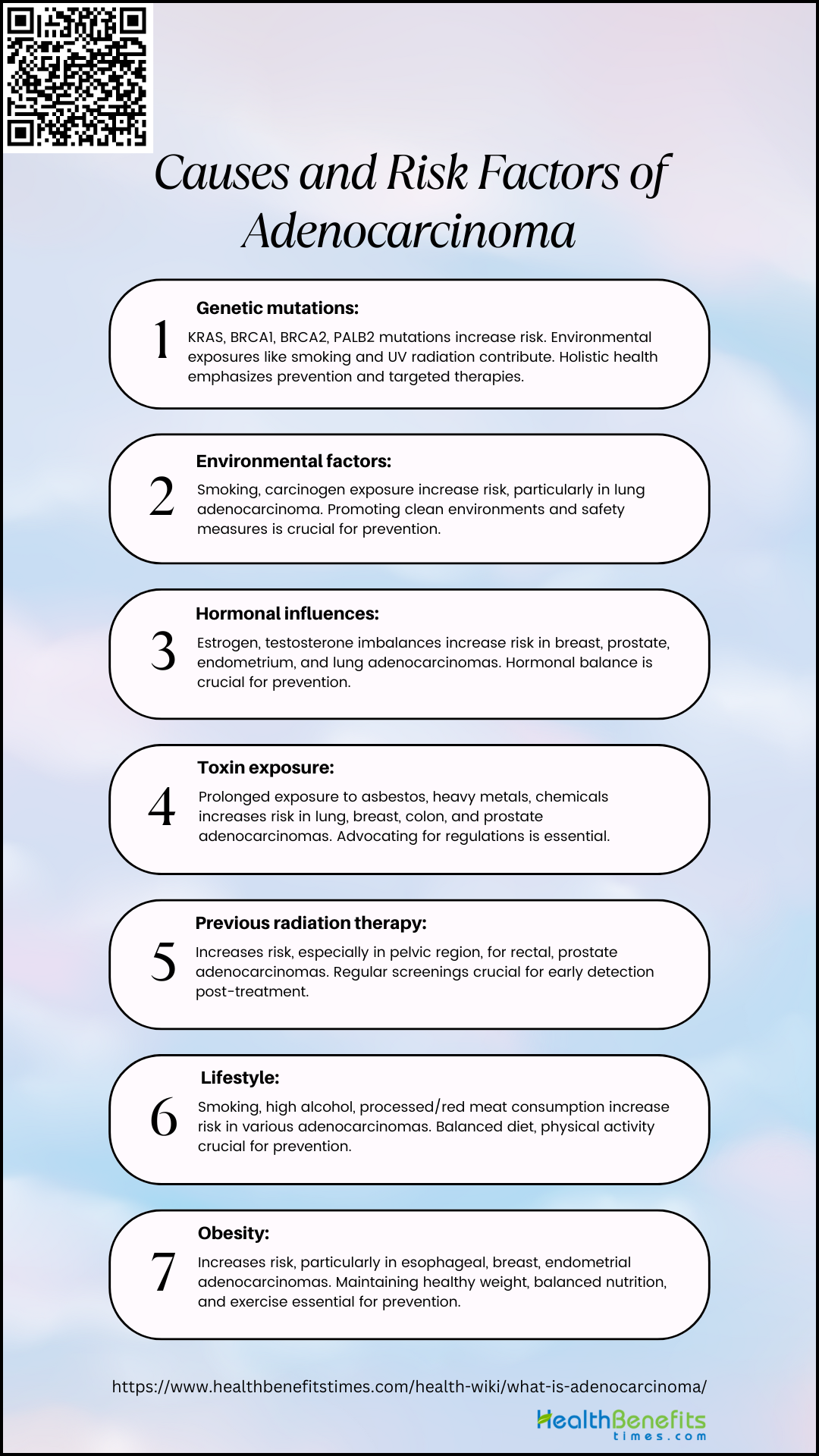
Common signs and symptoms of Adenocarcinoma (DND)
Adenocarcinoma, a prevalent form of cancer originating from glandular tissues, can present with a range of signs and symptoms that should not be ignored. Early identification of these indicators is essential for prompt diagnosis and treatment, in line with a comprehensive approach to health and well-being. In this article, we highlight the main symptoms linked to Adenocarcinoma to increase awareness and encourage proactive health care.
1. Coughing up blood or red phlegm
Coughing up blood, known as hemoptysis, is a concerning symptom that should be evaluated by a medical professional promptly as it may be indicative of a serious condition such as adenocarcinoma of the lungs. This type of cancer originates from mucous-secreting glands and is closely associated with risk factors such as smoking, exposure to secondhand smoke, and contact with carcinogens like asbestos and radon. Adenocarcinoma can also develop in individuals who do not smoke, underscoring the importance of seeking medical attention for anyone experiencing this symptom, particularly those with genetic predispositions or chronic lung diseases like COPD. Early identification of the underlying cause is crucial for implementing appropriate treatment strategies and improving health outcomes.
2. Chest pain exacerbated by breathing, coughing, or laughter
Chest pain that worsens with breathing, coughing, or laughter may indicate health problems such as adenocarcinoma, a type of cancer that typically originates in mucus-secreting glands, commonly in the lungs. Important risk factors for developing this cancer include genetic predisposition, exposure to environmental toxins such as tobacco smoke, and lifestyle choices. A holistic approach to health underscores the significance of recognizing these risk factors for early detection and implementing a comprehensive wellness plan. This plan should include regular health screenings, a balanced diet, physical activity, and mindfulness of one’s environment to reduce the likelihood of developing adenocarcinoma and improve overall well-being.
3. Hoarseness when speaking
Persistent hoarseness can serve as an early indicator of adenocarcinoma, a form of cancer that originates in mucus-producing glands and commonly affects the lungs or esophagus. This change in voice may be caused by a tumor affecting the nerves or structures of the vocal cords. Major risk factors for this type of cancer include smoking, exposure to secondhand smoke, environmental toxins such as radon and asbestos, chronic acid reflux, obesity, and a family history of cancer. Individuals experiencing hoarseness, especially those with these risk factors or other symptoms like unexplained weight loss or persistent coughing, should promptly seek medical attention. In the context of holistic health, timely recognition and intervention are crucial, potentially leading to early detection and a wider range of treatment options, thus leveraging the body’s innate ability to heal and maintain overall well-being.
4. Recurring lung infections, like bronchitis or pneumonia
Adenocarcinoma of the lung can present with a variety of symptoms, which may include recurring lung infections such as bronchitis or pneumonia. These infections are a result of the lung’s impaired ability to clear pathogens due to the presence of the tumor. Symptoms can range from being asymptomatic to more severe manifestations like cough, dyspnea, and pleural effusion. While not explicitly mentioned in the provided papers, recurring lung infections are a recognized clinical feature of lung adenocarcinoma in medical literature. These infections tend to recur due to the cancer blocking the airways, which promotes bacterial growth and impairs the lungs’ ability to clear out pathogens effectively. Individuals may experience a persistent cough with blood-tinged sputum, shortness of breath, and chest pain. These symptoms are sometimes mistakenly attributed to the infections rather than the cancer. It is crucial for these signs to be evaluated by a healthcare professional, as persistent or worsening symptoms require prompt attention for early diagnosis and treatment.
5. Wheezing without history of asthma
Experiencing wheezing in the absence of asthma may indicate a serious health issue such as adenocarcinoma, the most common type of lung cancer that originates in the mucus-secreting glands. This cancer can obstruct the airways in the lungs, resulting in a distinct high-pitched whistling sound, particularly during exhalation, as well as potential symptoms such as shortness of breath, chest pain, and a persistent cough. It is crucial for individuals experiencing these symptoms to seek prompt medical evaluation. Early detection of adenocarcinoma is essential, as it significantly impacts treatment options and can enhance the likelihood of a favorable outcome.
6. Unexplained weight loss
Unexplained weight loss is a common and concerning symptom of adenocarcinoma, often indicating an advanced stage of the disease. In gastric adenocarcinoma, weight loss accompanies symptoms like anorexia and early satiety. This unintentional weight loss may occur due to disruptions in the body’s metabolism and nutrient absorption caused by cancer cells, resulting in decreased muscle mass and fat stores. Additionally, the body may expend more energy in its efforts to combat the cancer. Any unexplained weight loss, particularly if not attributed to changes in diet or exercise, should prompt immediate medical evaluation. Early detection is crucial, so if sudden weight loss is observed without an apparent cause, seeking assessment from a healthcare provider is essential for prompt intervention and optimal disease management.
7. Loss of appetite
Loss of appetite, or anorexia, is a common symptom in individuals with adenocarcinoma, a cancer that originates in mucus-secreting glands. This condition can result in weight loss and malnutrition, compromising the patient’s health and complicating cancer treatments such as chemotherapy or radiation. The causes of anorexia in adenocarcinoma patients vary from the cancer’s impact on metabolism to the influence of cytokines on hunger signals and physical obstruction by tumors. Holistic health practices play a crucial role in managing this symptom, with a focus on maintaining nutritional status and improving quality of life. Strategies may include nutritional support, herbal remedies, and mind-body techniques to stimulate appetite and bolster the body’s resilience during treatment.
8. Feeling tired or weak
Patients with adenocarcinoma often experience a range of symptoms, with feeling tired or weak being a common and debilitating issue. This fatigue can be severe and persistent, significantly impacting quality of life and daily routines. It is frequently observed in advanced stages of cancer and can be exacerbated by treatments such as chemotherapy, which induces oxidative stress in non-targeted tissues like skeletal muscle, leading to further weakness and exercise intolerance. Unlike typical tiredness that improves with rest, this form of exhaustion is profound and persistent, hindering daily activities and impacting overall quality of life. While these symptoms may be associated with less severe conditions, they should not be disregarded and necessitate evaluation by a healthcare professional if they persist. Early detection and intervention are essential. For individuals managing adenocarcinoma, it is important to recognize that this fatigue may indicate the body’s response to the cancer or its treatment. Implementing comprehensive health strategies such as proper nutrition, gentle exercise, and stress management can help in managing this fatigue, complementing conventional medical therapies and promoting improved health and well-being.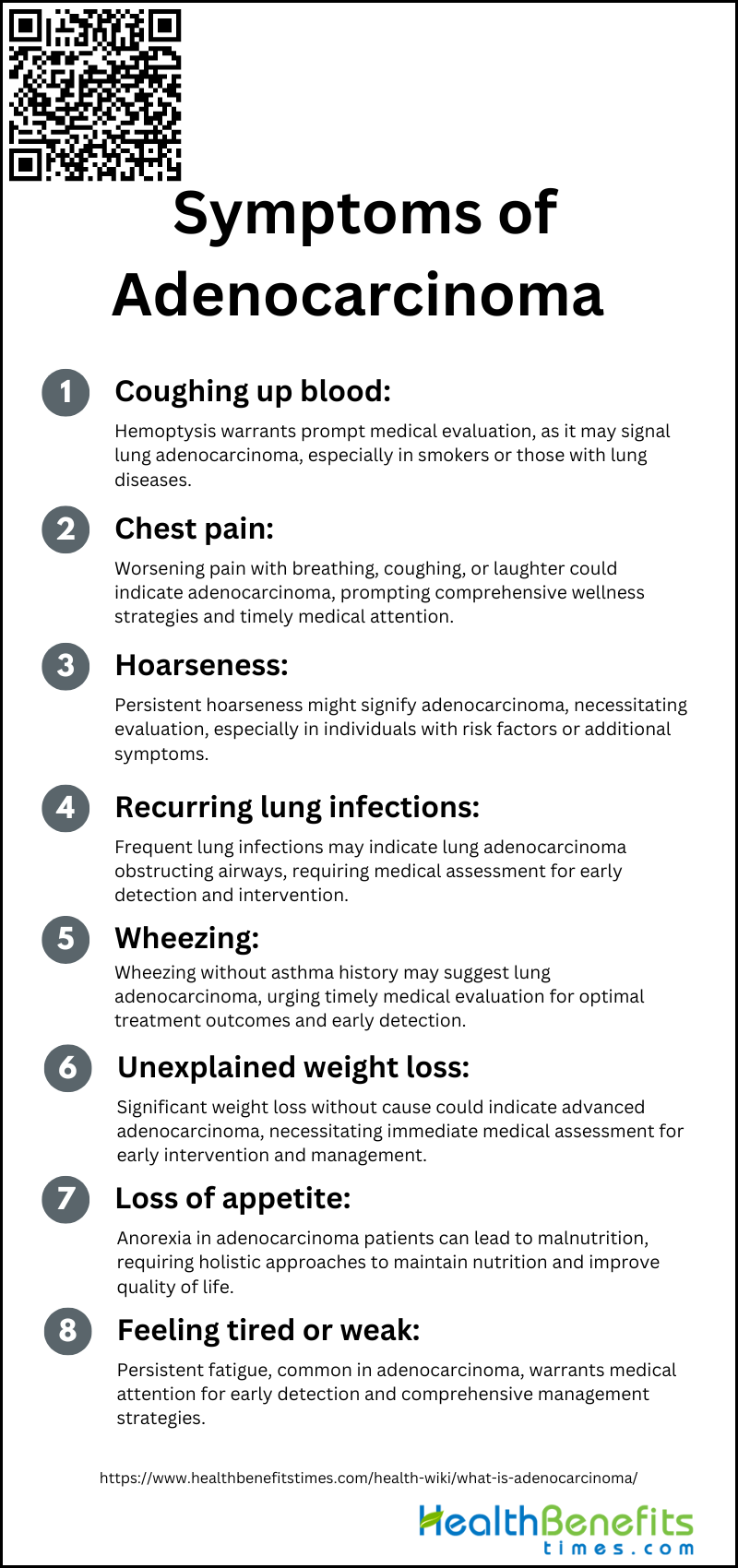
How to diagnose Adenocarcinoma
Adenocarcinoma, a common type of cancer that develops in the glandular tissues of the body, necessitates prompt and precise diagnosis for successful treatment. Familiarity with the diagnostic procedure is essential for patients and their families as they navigate the intricacies of this illness. The following are the essential steps in diagnosing adenocarcinoma, intended to offer clarity and direction during a difficult period.
1. Blood tests
Blood tests for diagnosing Adenocarcinoma include biomarkers like CYFRA 21-1 and HE4, which are useful in detecting recurrence post-surgery in lung adenocarcinoma. Blood tests are not definitive on their own; they provide important information about cell irregularities and organ function that may indicate the presence of cancer. A Complete Blood Count (CBC) can identify abnormalities such as anemia or abnormal white blood cell counts, which may suggest the presence of malignancy. Tumor markers like CA-125, CEA, and PSA are also monitored, as elevated levels of these markers can be linked to specific types of adenocarcinomas, although they can also increase due to non-cancerous conditions. Therefore, any abnormalities detected usually require further testing, including imaging studies and biopsies, to accurately diagnose the disease and determine its extent.
2. CT scan
The CT scan, also known as computed tomography scan, is an important non-invasive tool for the precise detection and management of adenocarcinoma, a type of cancer that originates in glandular or mucus-secreting tissues. To diagnose adenocarcinoma, CT scans are pivotal. They can detect the primary tumor site in patients with unknown primary metastatic adenocarcinoma. This imaging technique captures detailed images of the body’s internal structures from multiple angles, which are then reconstructed to create a comprehensive picture. This aids in accurately assessing the location, size, and extent of a tumor. CT scans are particularly effective in detecting adenocarcinomas in the lungs, pancreas, and esophagus, and are crucial in determining a treatment plan that aligns with the patient’s overall health and well-being. The ability of CT scans to provide clear insights without the need for invasive tissue sampling is highly valued.
3. MRI
Magnetic Resonance Imaging (MRI) is a critical tool in the diagnosis of adenocarcinoma, offering high sensitivity and specificity. For pancreatic adenocarcinoma, MRI, particularly with mangafodipir enhancement, is valuable for detecting small tumors that may be missed by CT, and can serve as a problem-solving tool when CT results are equivocal. By utilizing powerful magnetic fields and radio waves, MRI produces detailed images of the body’s internal structures, providing a non-invasive and precise examination of soft tissues. This imaging technique is particularly adept at pinpointing the exact location, size, and extent of adenocarcinomas in organs such as the lungs, colon, and prostate. It is especially effective for pancreatic adenocarcinoma, as it can delineate the tumor’s boundaries and its relationship to surrounding blood vessels and organs. MRI’s high contrast resolution is also valuable for identifying subtle lesions and small metastases that may be overlooked by other imaging methods. As a result, MRI plays a crucial role in a comprehensive treatment plan that combines conventional and holistic health approaches to promote overall well-being.
4. Biopsy
To diagnose adenocarcinoma, a biopsy is essential. This procedure involves extracting tissue samples for histological examination. For lung adenocarcinoma, an intraoperative optical biopsy using a folate receptor-targeted fluorescent contrast agent can rapidly identify malignancies with high accuracy. By extracting and analyzing a small tissue sample, pathologists can confirm the presence of cancer cells and identify the specific type of cancer, which informs a targeted treatment plan. The incorporation of this traditional medical technique with complementary therapies provides a comprehensive approach to wellness, enabling individuals to make informed decisions that align with their health beliefs. Advances in biopsy techniques, such as needle, image-guided, and surgical biopsies, ensure accuracy and minimize discomfort, highlighting the importance of the procedure in achieving an accurate diagnosis, effective treatment, and ultimately, a patient’s recovery and overall well-being.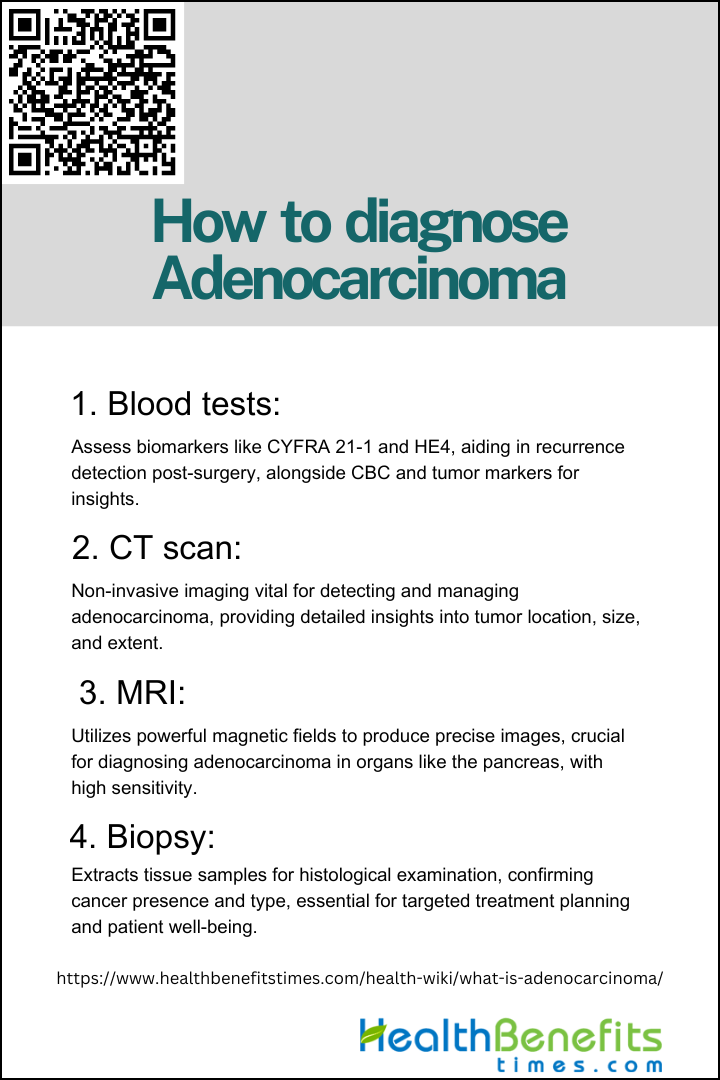
Stages of Adenocarcinoma
Adenocarcinoma is a common type of cancer that develops in the glandular tissues of the body and can impact multiple organs including the lungs, breasts, prostate, and colon. It is essential to comprehend the stages of this cancer for accurate diagnosis and treatment. In this study, we investigate the various stages of adenocarcinoma, offering insights into its progression and the implications for patient care.
1. Stage 0 adenocarcinoma
Stage 0 adenocarcinoma, also known as carcinoma in situ, represents the initial phase of this type of cancer in which abnormal cells have not spread beyond their original location. This early stage provides a crucial opportunity for early detection and treatment, with a favorable prognosis for individuals who are diagnosed. Treatment options may include minimally invasive procedures such as surgery or targeted therapy, which aim to remove only the abnormal cells while preserving healthy tissue. Incorporating both traditional and holistic health approaches, such as lifestyle and dietary modifications, can support the body’s natural healing processes. Regular screenings are vital for early detection, significantly improving the likelihood of a complete recovery and promoting a proactive approach to maintaining overall well-being.
2. Stage 1 adenocarcinoma
Stage 1 adenocarcinoma of the lung represents the earliest phase of the most common type of lung cancer, where the disease is localized and potentially curable through surgical resection. However, even at this initial stage, the risk of recurrence is significant. This initial stage of cancer, commonly found in the lungs, breast, or colon, is characterized by small, localized tumors that have not metastasized to other tissues or lymph nodes. Early detection is crucial as it allows for a variety of effective treatments, including surgical removal, which can be complemented by holistic approaches to promote the body’s natural healing and overall well-being. Regular screenings and a proactive approach to health are essential, especially for those at higher risk, empowering individuals to actively engage in their health journey and take advantage of this opportunity for potentially curative treatments.
3. Stage 2 adenocarcinoma
At Stage 2 cancer, the condition is at a critical juncture where the tumor has grown and may have spread to nearby tissues or lymph nodes, but has not yet metastasized to distant organs. This stage necessitates a personalized and comprehensive treatment plan, often involving surgery, chemotherapy, or radiation, tailored to the individual patient’s specific health needs. Holistic health approaches are integral in supporting the patient’s innate healing capabilities and overall well-being. These approaches encompass a balanced diet, stress management, and complementary therapies that complement conventional medical interventions. By integrating these modalities, healthcare providers strive to bolster both the physical and emotional resilience of patients, aiding them in navigating through this challenging stage with an emphasis on holistic wellness.
4. Stage 3 adenocarcinoma
In the progression of stage 3 adenocarcinoma, patients encounter a critical juncture as the cancer proliferates and infiltrates neighboring tissues and lymph nodes without spreading to distant organs. This stage is further categorized into 3A, 3B, and 3C based on the size of the tumor and the extent of lymph node involvement, which determines a tailored combination of surgery, chemotherapy, and radiation. A comprehensive health approach is essential, integrating these medical interventions with nutritional assistance, stress management, and complementary therapies to strengthen the body’s natural defenses and improve overall well-being. This holistic approach highlights the significance of ongoing monitoring and a comprehensive care plan, empowering patients and their caregivers to confront stage 3 adenocarcinoma with positivity and proactive management.
5. Stage 4 adenocarcinoma
In the fight against stage 4 adenocarcinoma, the most advanced form of cancer characterized by the spread of the disease to distant parts of the body, a comprehensive care strategy is essential. This critical stage poses a significant challenge, but holistic health approaches are aimed at enhancing the quality of life by combining conventional treatments like chemotherapy and radiation with complementary therapies. These supportive measures encompass dietary modifications, stress management, acupuncture, and herbal remedies, all customized to improve the body’s resilience and comfort. By focusing on an individualized plan that addresses physical, nutritional, and mental well-being, holistic care plays a crucial role in navigating the complexities of the disease, with the objective of not only survival but also promoting overall wellness.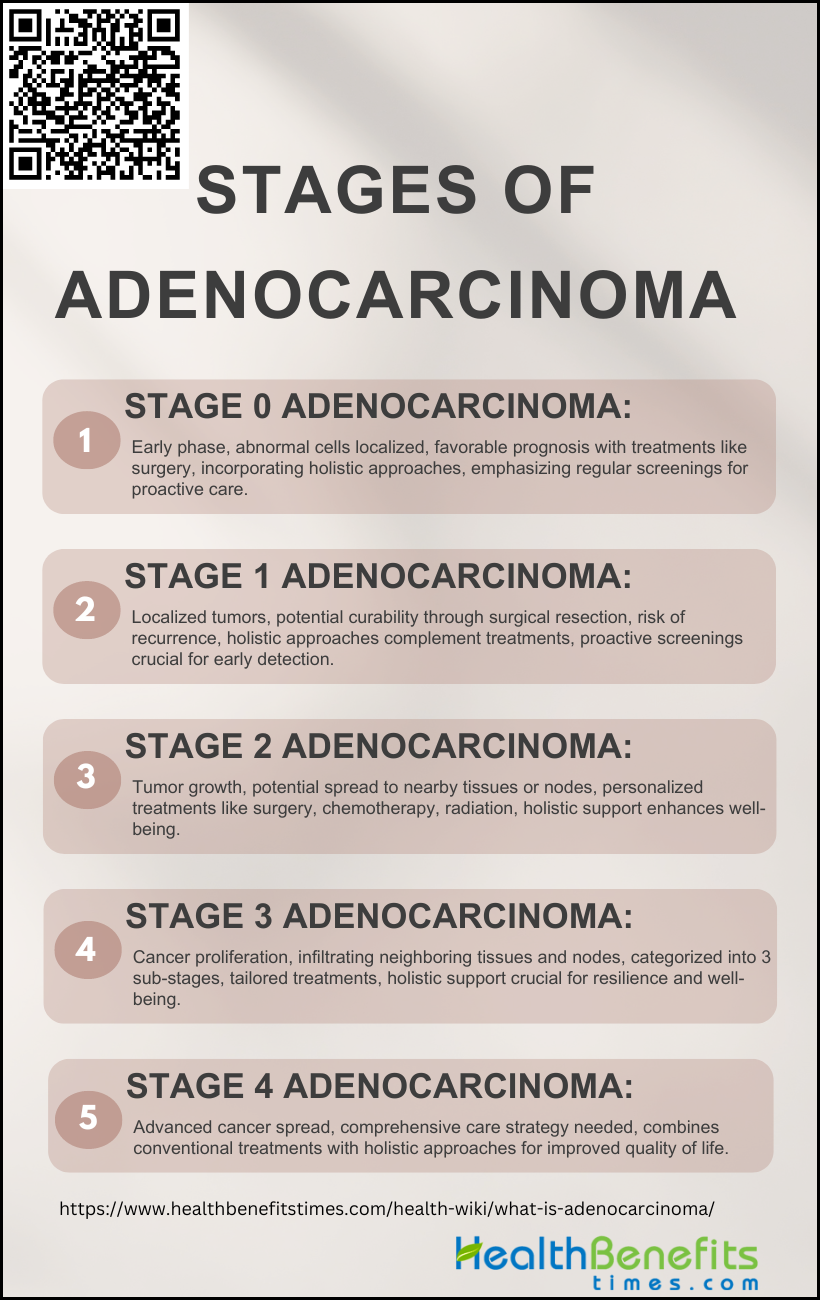
Treatment Options for Adenocarcinoma
Understanding the different treatment options available is essential for navigating the path to recovery. In this article, we discuss comprehensive approaches to managing adenocarcinoma, highlighting the significance of a holistic health perspective in improving overall wellness and treatment effectiveness.
1. Surgery
Surgery is a cornerstone in the treatment of adenocarcinoma, often offering the best chance for a cure. In esophageal adenocarcinoma, surgery alone is compared with multimodal therapy, which includes chemotherapy and radiotherapy before surgery, showing improved survival with the combined approach. The extent of the surgery is customized based on the characteristics of the tumor and the patient’s overall health. Specific procedures, such as the Whipple procedure for pancreatic adenocarcinoma or pancreaticoduodenectomy for duodenal adenocarcinoma, are chosen based on the details of the cancer. Taking a holistic approach to health, incorporating complementary therapies like nutrition and acupuncture alongside traditional surgical treatment is important. This approach promotes natural healing and emphasizes the importance of patients having open discussions with their healthcare providers to make decisions that align with their wellness goals and personal health beliefs.
2. Radiation therapy
Radiation therapy is a pivotal treatment for adenocarcinoma, with various studies showing its effectiveness. For cervical adenocarcinoma, radiation alone has shown promising long-term results, with survival rates varying significantly by stage and tumor volume. However, it is important to be aware of potential side effects such as fatigue and changes in skin condition. Our holistic health website emphasizes the significance of integrating radiation therapy into a comprehensive care plan that promotes overall well-being. This includes adopting a balanced diet, engaging in appropriate physical activity, and utilizing stress management techniques. Collaborating closely with healthcare professionals is essential in developing a personalized treatment strategy that aligns with a patient’s health goals and enhances their quality of life throughout the recovery process.
3. Chemotherapy
Chemotherapy is a cornerstone in treating adenocarcinoma, often combined with other modalities for enhanced efficacy. In advanced cervical adenocarcinoma, chemoradiation with adjuvant cisplatin-based chemotherapy has shown significant improvements in disease-free and overall survival rates compared to chemoradiation alone. The main objective of chemotherapy is to eradicate rapidly dividing cancer cells; however, it can also result in side effects such as fatigue, nausea, and hair loss due to its impact on healthy cells. Incorporating complementary therapies like acupuncture, meditation, and nutritional counseling can help alleviate the negative effects of chemotherapy and enhance the body’s resilience. It is crucial for patients to collaborate with their healthcare providers to develop a personalized treatment plan that integrates these holistic practices with conventional cancer therapies, ensuring a comprehensive path to recovery.
4. Targeted therapy
Targeted therapy is a precise and thoughtful approach to treating adenocarcinoma, a common cancer that originates in glandular tissues. This innovative treatment targets the specific genetic markers of cancer, sparing healthy cells and maintaining the body’s balance. By targeting the molecular drivers of cancer growth and spread, targeted therapy provides a less invasive option that aligns with the body’s natural healing mechanisms. The introduction of molecular testing has increased access to this personalized care, improving patients’ quality of life and marking a significant advancement in incorporating wellness into cancer treatment approaches. Targeted therapy has revolutionized the treatment of adenocarcinoma by focusing on specific genetic aberrations within tumors. The success of targeted therapies hinges on identifying actionable mutations, as seen with the use of crizotinib for c-met-amplified lung adenocarcinoma.
5. Immunotherapy
Immunotherapy has become a cornerstone in treating various adenocarcinomas, including pancreatic, lung, and gastroesophageal cancers. Advances in immunotherapy, such as checkpoint inhibitors and bi-specific antibodies, have shown promise in preclinical and clinical trials, particularly when combined with other treatments to enhance efficacy or overcome resistance. While not suitable for all cases, immunotherapy has shown efficacy in treating lung and colorectal cancers, providing a comprehensive option that may lead to reduced side effects and improved quality of life for patients. Its alignment with holistic health principles offers hope to individuals seeking alternatives to traditional treatments like chemotherapy and radiation therapy.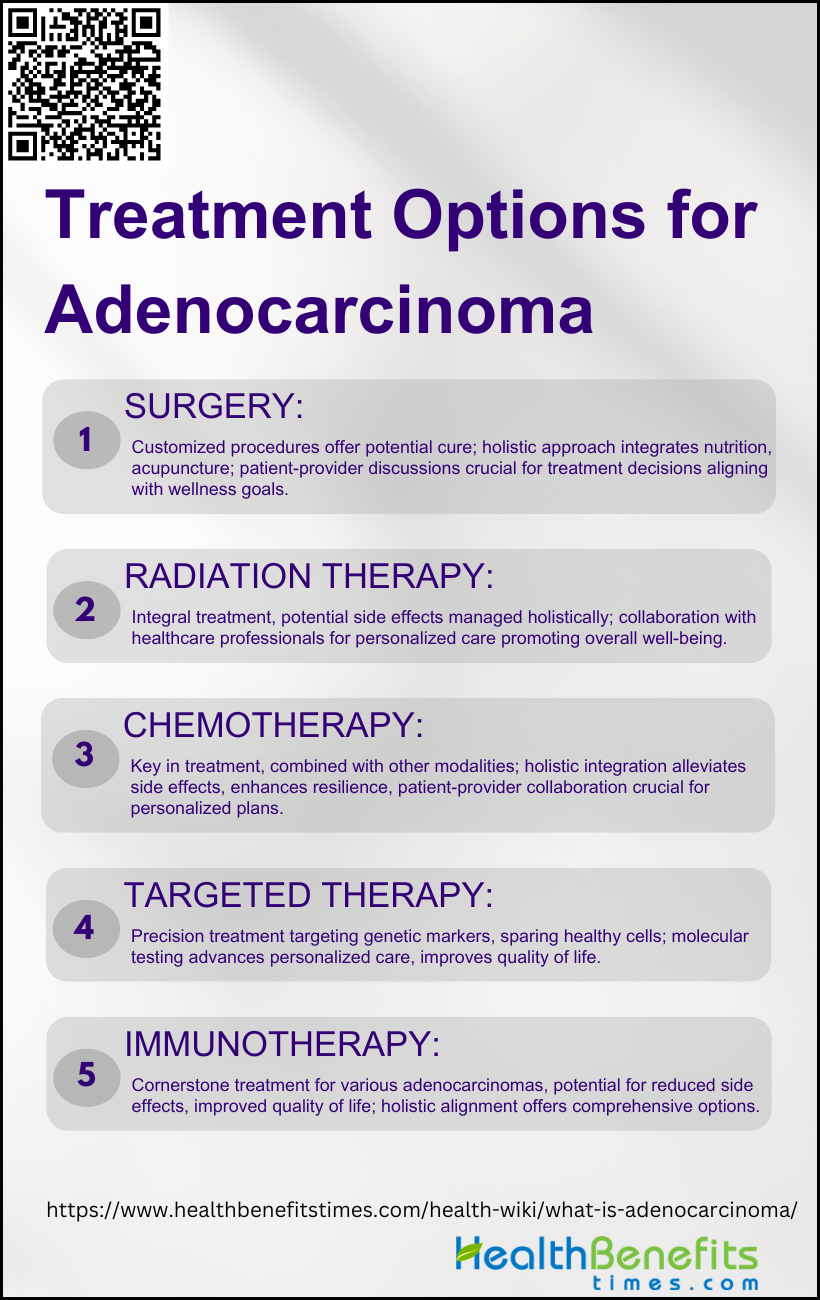
Side effects of adenocarcinoma treatment (DND)
The process of healing from adenocarcinoma involves a variety of treatment methods, each with its own potential side effects. While these treatments are designed to target and eradicate cancer cells, they may also unintentionally affect the body’s normal functions and overall well-being. In the following section, we detail the main side effects that patients may experience throughout their treatment process.
1. Anemia
2. Diarrhea
3. Bruising
4. Constipation
5. Swelling from excess fluid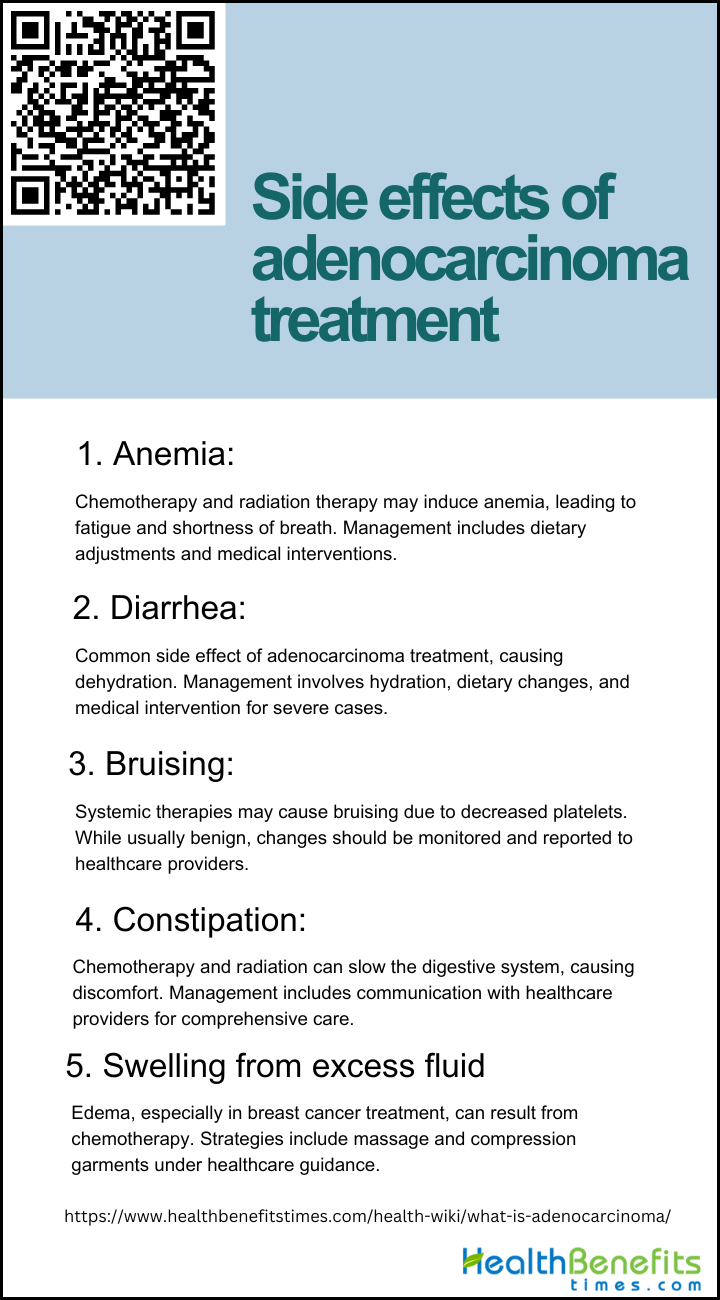
Prevention and Early Detection (DND) of Adenocarcinoma
Below, we outline key strategies that can help prevent and detect adenocarcinoma early, enabling individuals to take proactive steps towards maintaining their health.
1. Avoid tobacco products
Avoiding tobacco products is a critical strategy in the prevention and early detection of adenocarcinoma. Research has established a strong link between cigarette smoking and increased risks of lung and esophageal adenocarcinomas, with a clear dose-response relationship. Tobacco contains harmful carcinogens that significantly increase the risk of developing cancers in the lungs, esophagus, and pancreas. Choosing to abstain from cigarettes, cigars, pipe tobacco, and snuff not only decreases the chances of developing adenocarcinoma but also promotes a comprehensive approach to health. This prudent health decision has broader benefits, including improved cardiovascular health and enhanced respiratory function, which are essential for overall well-being and protection against the insidious threat of adenocarcinoma.
2. Be physically active
Regular physical activity is a crucial component in the battle against adenocarcinoma, a form of cancer that originates from glandular tissue. By incorporating at least 150 minutes of moderate to vigorous exercise such as walking, cycling, or swimming into your weekly routine, you can boost your immune system, maintain a healthy weight, and improve digestive efficiency. This not only reduces the risk of breast, colon, and prostate cancers but also enhances the body’s natural defense mechanisms by reducing inflammation and enhancing immune function. Advocates for holistic health, fitness, and wellness emphasize the importance of exercise in promoting overall well-being and taking proactive steps to prevent the onset and progression of cancer.
3. Maintain a healthy weight
Maintaining a healthy weight is pivotal in the prevention and early detection of adenocarcinoma. Epidemiological evidence suggests that overweight and obesity increase the risk for several cancers, including esophageal adenocarcinoma. Weight control, particularly avoiding weight gain during adulthood, is recommended to reduce this risk. Adopting a holistic lifestyle that includes a diet rich in fruits, vegetables, and whole grains, along with regular exercise, helps in controlling weight. This not only reduces the risk of cancer by reducing inflammation and balancing hormones but also improves overall health and the effectiveness of cancer screenings. As a result, taking a proactive approach to wellness can significantly enhance the chances of successful cancer treatment and recovery.
4. Eat a well-balanced diet
Adopting a balanced diet is crucial for the prevention and early detection of adenocarcinoma, a type of cancer that originates in mucus-secreting glands commonly found in the esophagus and colon. A diverse diet that includes plenty of fruits, vegetables, whole grains, and lean proteins, particularly cruciferous vegetables such as broccoli and kale, provides essential nutrients that enhance the body’s defense mechanisms against cancerous changes. Foods high in fiber and antioxidants are important in reducing the risk of cancer, while limiting the intake of processed foods, red meats, and sugars helps in maintaining a healthy weight, which is key in reducing the risk of obesity-related cancers. Taking a comprehensive approach to nutrition not only promotes overall well-being but also enhances the body’s natural ability to detect and manage early signs of disease, making diet a powerful ally in the battle against cancer.
5. Visit your healthcare provider regularly
Regular check-ups with your healthcare provider are essential for maintaining good health and are particularly important for the early detection and prevention of adenocarcinoma, a type of cancer that originates from glandular tissue. These visits allow healthcare professionals to perform screenings and offer valuable insights into your health, potentially identifying subtle changes that require attention. By incorporating these check-ups into your routine, along with a balanced diet, exercise, and mindfulness, you can take a comprehensive approach to wellness that can significantly enhance your chances of detecting health issues early. Early detection is crucial, as it provides more effective treatment options, underscoring the importance of prioritizing regular medical consultations on your journey to health and well-being.

